|
|
|
Sort Order |
|
|
|
Items / Page
|
|
|
|
|
|
|
| Srl | Item |
| 1 |
ID:
154380
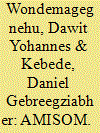

|
|
|
|
|
| Summary/Abstract |
The African Union Mission in Somalia (AMISOM) is an atypical peace support operation (PSO) that has evolved sui generis and continues to chart its own trajectory politically and militarily. With a view to contributing to the African Union (AU) Commission’s policymaking process and articulation of its PSO doctrine, this article examines AMISOM’s various distinct features, especially as they relate to the mandating process, mission support arrangements, and interactions with the Somali National Security Forces (SNSF). The article argues that there is a clear need for the AU to articulate a PSO doctrine appropriate to the types of missions which the AU undertakes, both now and in the near future. AMISOM’s initial mandating process was event-driven rather than context-driven, and the mission operated was based on a logistic supply arrangement that was at times not in sync with its overall operational demands. While the mission has multifaceted interactions with the SNSF, the interplay was fragmented, not least due to a multiplicity of actors and interests. A reading of the AMISOM experience underlines that the design of the AU’s contemporary peace missions’ doctrine should be centred on an integrated and mutually-reinforcing relationship among operations, institution-building, logistical support, and politics.
|
|
|
|
|
|
|
|
|
|
|
|
|
|
|
|
| 2 |
ID:
154378


|
|
|
|
|
| Summary/Abstract |
This article aims to chronicle and analyse the transformation of the army of the Ethiopian People’s Revolutionary Democratic Front (EPRDF) into a national army following its military and political triumph in 1991. The history of a modern army in Ethiopia is recent, beginning with the end of the Second World War. Since then, the Ethiopian army has gone through major changes under different regimes. However, it is only the latest version of the national army that has a properly organised military doctrine and strategy. Prior to this, the army’s concept of operations was shaped by the doctrines and strategies of its foreign sponsors. The organisation of the imperial army was influenced by the doctrine and strategy of Western armies (initially the British and later the Americans); the army’s concept of operations during the military regime was shaped by Soviet senior military advisors. The EPRDF army was an insurgent army that developed into a conventional army with its own set of military and military–political institutions, including its own military doctrine and its own concept of the science and art of war. The transition of the EPRDF army into a national army is a unique example of restructuring a people’s army into a national military, something rarely if ever attempted with this kind of comprehensiveness.
|
|
|
|
|
|
|
|
|
|
|
|
|
|
|
|
| 3 |
ID:
154381
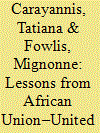

|
|
|
|
|
| Summary/Abstract |
Having hosted nearly a dozen peacekeeping and peacebuilding efforts since the mid-1990s, the Central African Republic (CAR) has been a laboratory for peace interventions – an ‘early adopter’ of various peace initiatives. It is thus a useful case from which to draw preliminary conclusions about the roles of the United Nations (UN) and regional organisations in resolving conflicts that involve entire regions. This article examines the roles of the UN and the African Union (AU) in CAR, where there is a long history of successive conflict resolution efforts that have been overseen by the international community and the region alternatively. The AU, regional economic communities (RECs) such as the Economic Community of Central African States (ECCAS), and regional leaders have also played important roles during the many initiatives aimed at resolving conflict in CAR. This article analyses the responses and relationship between these institutions and actors, beginning with the deployment of an inter-African monitoring mission in 1997. It is argued that peace operations in CAR have lacked a clear political strategy and a clear understanding of the situation, as well as the necessary sustained engagement from both regional and international actors. It is further argued that each subsequent intervention has added an additional layer to the previous one, thus creating a proliferation of peace operations whose mandates, troop contingents and leadership have not always been fit for purpose.
|
|
|
|
|
|
|
|
|
|
|
|
|
|
|
|
| 4 |
ID:
154376
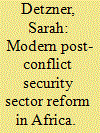

|
|
|
|
|
| Summary/Abstract |
This piece examines recurring patterns in the ‘where’ and ‘how’ of security sector reform (SSR) implementation failures in post-conflict African SSR programmes featuring substantial external involvement that have been undertaken since the mid-1990s. It finds, briefly that in these efforts, gaps in SSR implementation have tended to occur at the same points in the SSR process repeatedly. The most common issues include failures to correctly assess the post-conflict security environment, failures to ensure local ownership of reform efforts, failures to devote sufficient resources and attention to disarmament, demobilisation and reintegration (DDR, a process with close ties to SSR and force integration), failures by donors to coordinate goals and resources, and failures to include critical parts of both the de jure and de facto security sector in reforms. Post-conflict African success stories also share common characteristics, most notably a deep and wide level of societal involvement at most stages of the SSR process. These patterns, analysed as a necessary first step to discovering the ‘why’ of implementation failures in such cases, collectively suggest a focus on the early mobilisation of domestic political demand for SSR, rather than on varying methods of applying external pressure, as a fruitful avenue for future research.
|
|
|
|
|
|
|
|
|
|
|
|
|
|
|
|
| 5 |
ID:
154379
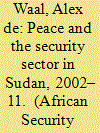

|
|
|
|
|
| Summary/Abstract |
This paper examines how contests over military control were played out during peace negotiations and in the implementation of agreements (including the manipulation or violation of the terms of agreements) in Sudan between 2002 and 2011. The cases examined are the Comprehensive Peace Agreement (CPA) of 2005, the Darfur peace talks which took place from 2003 to 2011, and the post-referendum arrangements talks of 2011. The central arguments presented are as follows: the principal political players consistently sought control over the military as a main component of their political strategies; senior military officers posed a threat to the power of nominally civilian leaders; security arrangements were determined by a combination of the leaders’ calculations over their internal power base along with their expectations of ongoing or anticipated armed conflicts; and external programmes and policies for security sector reform were manipulated and instrumentalised in pursuit of these power goals.
|
|
|
|
|
|
|
|
|
|
|
|
|
|
|
|
| 6 |
ID:
154374
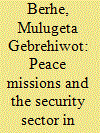

|
|
|
| 7 |
ID:
154377
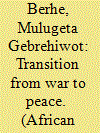

|
|
|
|
|
| Summary/Abstract |
The objective of this paper is to chronicle the 1991 to 1997 Ethiopian disarmament, demobilisation and reintegration (DDR) experience in the context of Ethiopia’s transition from war to peace. The DDR project is usually a post-conflict political project that should be analysed in the overall context of transition from war to peace. The literature on the Ethiopian experience is focused on the technical aspects of the programme and the assessment of its impacts, with little to no attempts made to capture the experience in the context of Ethiopia’s transition from war to peace. Given that there are many existing and several incoming post-conflict countries, capturing the successful Ethiopian DDR experience is important, as some aspects will inform the design of ongoing and upcoming transitions from war to peace. This paper illustrates the wider challenges of the transition from war to peace as a context for the DDR programme, delves into the key strategies and elements of the programme, and summarises its impact assessment. In the conclusion, the key lessons to be learned from the experience are laid out.
|
|
|
|
|
|
|
|
|
|
|
|
|
|
|
|
|
|
|
|
|